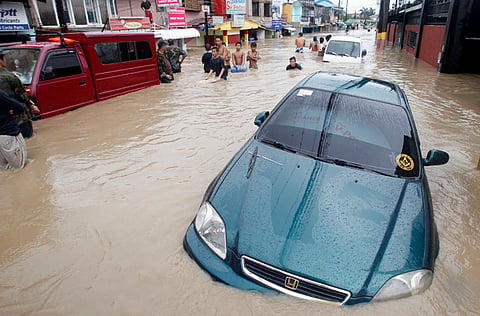Floods cause havoc in China, Philippines
China death toll reaches 74, with many people missing in Philippines

Beijing/Manila: Devastating floods left 74 people dead and forced hundreds of thousands to evacuate their homes in China in recent days, officials said on Monday.
Flooding in the north-east which left 54 people dead was described as “the worst in decades” by state news agency Xinhua, while another 20 people died in the southern province of Guangdong as a result of the weather, the ministry of civil affairs said.
A further seven people were missing in Guangdong, where 510,000 were evacuated because of the rain, the ministry said.
Transport links were severely crippled, affecting tens of thousands of travellers.
Some services from Guangzhou railway station, Guangdong’s most important transport hub, were suspended due to rain and landslides.
State media said 80,000 passengers were stranded over the weekend because of the disruption.
More than 2,800 soldiers have been drafted in to help with the relief efforts, Xinhua reported.
Meanwhile, torrential rain paralysed large parts of the Philippine capital Monday as neck-deep water swept through homes, while floods in northern farming areas claimed at least three lives.
Schools, government offices and the stock exchange closed as a red alert was raised in the morning, the highest level of a warning system in which widespread floods are predicted.
Two remained missing in northern Luzon.
Some 559 families were affected by 30 millimetres per hour of rains that inundated northern Luzon, Metro Manila, and southern Luzon.
Schools, government offices and private banks were closed in all affected areas nationwide, Undersecretary Eduardo del Rosario, head of the National Disaster Risk Reduction and Management Council, said.
Sta. Maria and Narvacan towns in Ilocos Sur, in northern Luzon and five other towns including Sta. Rosa and San Pedro towns in Laguna, southern Luzon were placed in a state of calamity, del Rosario said.
“We are trying to save whatever we can. But it was so sudden,” J.R Pascual, a father-of-four, said as he tried to take the most important possessions from his home that was flooded up to his waist.
“My neighbour wasn’t even able to get his car out.”
Roads from Cavite and other southern areas into the city were impassable, while some motorists who tried to get through the flooded streets were forced to abandon their cars.
Footage on ABS-CBN television showed people in nearby shanty town communities standing on their corrugated iron roofs, as fast-moving water swept through the windows of their homes.
By early afternoon, the rain had eased and the red alert was lowered for the capital.
One of President Benigno Aquino’s top aides said he did not expect a major disaster.
“Compared to other calamities, this is not of the same gravity as the rest. I hope this will be done by tomorrow,” Executive Secretary Paquito Ochoa told a nationally televised government disaster briefing.
Nevertheless, thousands of people were believed to be sheltering in evacuation centres or trapped on rooftops while waiting for the water to subside.
Weather forecasters also said more rain was expected to hit Manila in the early evening, while farming towns and mountainous areas reaching hundreds of kilometres to the north on the main island of Luzon were enduring heavier storms.
The National Disaster Risk Reduction and Management Council said some northern regions were experiencing floods of 1.2 metres, following persistent rain that began at the weekend.
— With inputs from Barbara Mae Dacanay, Bureau Chief
Sign up for the Daily Briefing
Get the latest news and updates straight to your inbox



